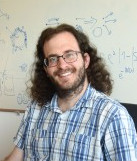Seminar Videos
Nowadays, computationally efficient many-body methods can be used to perform first-principles calculations for atomic nuclei up to mass A~150. This progress has made it possible to confront modern two- and three-nucleon interactions from Chiral Effective Field Theory with a wealth of experimental data, and provide important guidance in their ongoing refinement. In my talk, I will focus one such many-body approach, the In-Medium Similarity Renormalization Group (IMSRG). The IMSRG not only offers a means to directly compute certain nuclear properties, but also provides a powerful framework for designing "hybrid" methods that allow us to tackle nuclei with strong collective correlations, e.g., due to intrinsic deformation. I will discuss the basic ideas underlying the IMSRG framework, and present recent applications to the first-principles description of (doubly) open-shell nuclei, including candidates for fundamental symmetry tests. |
If there is one thing we learned about the synthesis of heavy elements in the Universe during the last 10 years, it’s that it is complicated business. Three astrophysical processes were proposed initially, since the birth of nuclear astrophysics in the 1950s, to describe the production of all heavy elements. These three processes (p, s, and r) are still strong contributors and still exhibit significant open questions. However, today we understand that other processes may have significant contributions to the production of heavy elements as well. This talk will present the new complex picture of heavy-element nucleosynthesis, focusing on the astrophysical i-process, which is intermediate between the s- and r-neutron-capture processes. The main focus will be on neutron-capture reactions, the most important nuclear physics input needed to constrain the i process. I will discuss recent experiments performed at the National Superconducting Cyclotron Laboratory at Michigan State University, and at the CARIBU facility at Argonne National Laboratory. Finally, I will present exiting new opportunities that open up at the Facility for Rare Isotope Beams (FRIB) in the near future. |
Total absorption gamma spectroscopy is one of the few techniques available that can provide beta decay data free from the systematic error called Pandemonium effect. The technique is particularly important for nuclear structure studies, in cases where a proper determination of the beta decay strength in the daughter nucleus is necessary. Results obtained employing the technique are also relevant for practical applications, such as the determination of the reactor antineutrino spectrum in reactors and estimations of the decay heat based on summation calculations. In this talk, I will present the technique, and some examples of recent measurements of relevance for reactor applications. The antineutrino related results are of particular interest in relation to the so-called antineutrino reactor anomaly. . |
The investigation of the binding energy of atomic nuclei dates back to the origins of nuclear physics. The well-known empirical mass formula, developed by Bethe and Weizsäcker, accurately describes the global aspects of nuclear binding for most of the nuclear chart. Its success is largely due to the saturating nature of the constituent nucleons in nuclei. Therefore, the saturation energy of nuclear matter is traditionally extrapolated from the empirical mass formula. To investigate this extrapolation, I will present binding-energy densities of 12C, 40Ca, 48Ca, and 208Pb calculated using a dispersive optical model constrained by all relevant data. These energy densities reveal that the nuclear interior minimally contributes to the total binding energy. Thus, the volume contribution to the binding energy in the interior is not well-constrained. These results call into question the degree to which the equation of state of nuclear matter is constrained by the empirical mass formula. |
Transcript (auto generated) |
In the wake of the discovery of superheavy elements, nuclear spectroscopy experiments aim at providing anchor points at the uppermost end of the nuclear chart for nuclear structure theory, which otherwise had to solely rely on extrapolations. In two runs in 2019 and 2020, such a nuclear spectroscopy experiment was conducted to study α-decay chains stemming from isotopes of flerovium (element Z = 114). The U310 experiment employed an upgraded TASISpec decay station placed behind the gas-filled separator TASCA. The fusion-evaporation reactions 48Ca+242Pu and 48Ca+244Pu provided a total of 32 flerovium-candidate decay chains in effectively 18 days of beam time. Two and eleven decay chains were firmly assigned to even-even 286Fl and 288Fl isotopes, respectively. The – admittedly unexpected – observations include (i) an excited 0+ state at 0.62(4) MeV excitation energy in 282Cn, and (ii) a Qα = 9.46(1) MeV decay branch (1 out of 51) from 284Cn into 280Ds [1]. Both observations indicate that there is hardly any shell gap at proton number Z = 114 - at least not at neutron numbers N ≈ 172-174. The remaining decay chains stemming from 289Fl indicate the presence of α-decay fine structure as has been theoretically predicted for odd-A Fl-decay chains. This is the focus of an ongoing analysis [2]. These discoveries are only possible with regular advances in detector systems. Once finalized, the new Lundium station will take the novel Compex germanium detectors and operate them without frontcaps, within a vacuum chamber. In doing this Lundium lower the spectroscopic limit and allow hitherto inaccessible measurements to be performed. A commissioning experiment is planned for 2022 to study neutron-deficient plutonium isotopes and their decay products. Here there are many open questions. It is then envisioned to run a full superheavy campaign once commissioning is completed. [1] A. Såmark-Roth et al., Phys. Rev. Lett., 126, 032503 (2021). [2] D.M. Cox et al., to be submitted to Phys. Rev. Lett. |
The often surprising properties of neutron-rich nuclei have prompted extensive experimental and theoretical studies aimed at identifying the drivers behind the dramatic changes encountered in the exotic regime. In-beam nuclear spectroscopy with fast beams and thick reaction targets where gamma-ray spectroscopy is used to tag the final state provides information on the single-particle structure as well as on collective degrees of freedom in nuclei that are available for experiments at beam rates of only a few ions/s. This presentation will show how in-beam experiments measure complementary observables that advance our understanding. The interplay of experimental results and theory will be emphasized at the intersection of nuclear structure and reactions in the joint quest of unraveling the driving forces of shell evolution. |
Transcript (auto generated) |
Unlike any other physical system the nucleus represents a unique dual quantum many-body system. Its constituents, protons and neutrons, can be seen as two representations of the nucleon, with isospin components tz = ±1/2 for neutrons and protons, respectively. Under the assumption of charge independence of the strong interaction, hence invariance under rotation in the isospin space, the excitation energy spectra of mirror nuclei should be identical. Isospin breaking effects, besides the dominating electromagnetic force, are usually studied through mirror energy differences, testing the charge symmetry and triplet energy differences, testing the charge independence of the nuclear force. However, a more rigorous way to test isospin symmetry are electromagnetic matrix elements. In this talk I will present the results of our study of the A = 70, T = 1 triplet performed at the Radioactive Isotope Beam Factory at the RIKEN Nishina Center in Japan. Proton-rich beams were produced by projectile fragmentation and identified using the BigRIPS separator. Coulomb excitation was induced by a secondary Au target, located in the center of the DALI2 γ-detector array to measure the excitation probabilities. The measurement on 70Kr revealed a much larger cross section for the excitation of the first 2+ state than would be expected from its mirror 70Se. This can be interpreted as an unexpected shape change in the mirror nuclei and the new results present a challenge to the theoretical modeling of atomic nuclei. |
Transcript (auto generated) |
The evolution of the universe has left an imprint in the form of the chemical elements. The abundances of elements we see in our solar system, distant stars, meteorites, and in stellar explosions provide us with clues about how the elements came to be produced in a variety of different processes and stellar environments. To unravel these mysteries we need to understand the nuclear reactions producing and destroying the elements. Neutron induced reactions play a key role for the formation of elements heavier than iron. After introducing neutron capture nucleosynthesis, I will talk about recent neutron induced reaction studies and their relevance to our understanding of the origin of the elements. |
Transcript (auto generated) | ||
A new high-resolution gamma-ray spectroscopy setup has been recently installed at a thermal neutron beam at the Institut Laue-Langevin (ILL, Grenoble). FIPPS (Fission Product Prompt gamma-ray Spectrometer) has been used to study the structure of nuclei in different region of the nuclear chart, by means of neutron induced reactions on stable (rare) and radioactive targets. The instrument consists of a pencil-like thermal neutron beam coupled to a high-resolution and efficiency gamma spectrometer. After a general introduction about the nuclear physics activities at the Institut Laue-Langevin, recent results obtained in different experiments at FIPPS will be reported. Particular focus will be dedicated to the first fission campaigns, showing the innovative technique of fission tagging and first results. |
Transcript (auto generated) | ||
The element distribution we observe in the Universe, and in particular the diverse abundances of atomic nuclei, tells a fascinating story of nucleosynthesis events that have taken place throughout the 13.7-billion-year-long history starting with the Big Bang. Since the groundbreaking works of Burbidge, Burbidge, Fowler and Hoyle and Cameron in 1957, it has been known that radiative neutron-capture reactions play a major role in synthesizing elements heavier than iron. However, many questions remain when it comes to our understanding of neutron-capture processes in various stellar environments. In particular, the intermediate and rapid neutron-capture processes are very challenging to describe, as they involve neutron-rich nuclei for which there exist little or no data on crucial input such as neutron-capture rates. In this presentation, possibilities to obtain indirect, experimental constraints of these rates by means of the Oslo method and the beta-Oslo method will be discussed. |
Transcript (auto generated) | ||
The modeling of nuclear structure properties of neutron-rich nuclei is a crucial ingredient for understanding the production of heavy elements during the rapid neutron capture process (or r-process). In order to properly interpret future kilonova observations, sensitivity studies addressing the impact of nuclear theoretical uncertainties are required. In this talk, I will present some recent network calculations based on nuclear input obtained within the Density Functional Theory (DFT) framework. In particular, I will focus in the role of nuclear masses and fission properties in the production of translead nuclei, and the possible implications for the electromagnetic counterparts produced during neutron star mergers. In the second part of this talk, I will introduce some recent advances regarding the large-scale DFT calculation of fission fragments distributions and the estimation of theoretical uncertainties using Bayesian machine-learning techniques. |
Transcript (auto generated) | ||
The nuclear physics group at the University of Oslo primarily dedicates to perform experimental studies of the main average nuclear properties: the nuclear level density and the γ-ray strength function (γ-SF). These quantities are crucial inputs for calculating neutron capture rates relevant for stellar nucleosynthesis simulations. The scissors mode is a collective, magnetic dipole excitation that has been observed in the 2-4 MeV region of the γ-SF in a large group of deformed nuclides. The scissors mode could be of particular importance in the region of the heaviest elements, where the presence of a large resonance in the γ-SF could boost the neutron capture channel relative to fission. In this work, we obtained an experimental spectrum of 254No from which we estimate the strength of the scissors resonance and compare it to theoretical values and empirical formulas used in nuclear reaction codes. |
Transcript (auto generated) | ||
Static octupole correlations, which are associated with reflection symmetry breaking at the mean field level, are only present in a handful of nuclei scattered over the periodic table around specific proton and neutron numbers. This is in contrast with the well known prevalence of quadrupole-deformed over spherical shapes in nuclei. However, dynamical correlations, consequence of the relative softness of the nucleus against perturbation of octupole kind, are present in most of the nuclei. They play a role in understanding excitation energies and transition strengths of collective negative parity excitations. In this talk I will address the theoretical description of octupole correlations with techniques beyond the mean field, including symmetry restoration and configuration mixing. The results of calculations along that line will be analyzed. |
Transcript (auto generated) | ||
Nucleon removal (p,pn) and (p,2p) reactions at intermediate energies have proven to be a strong tool to extract information from exotic nuclei. In this talk, several results for (p,pn)and (p,2p) reactions are presented, using the Transfer to the Continuum formalism for their description. Particular interest is devoted to the dependence of the so-called reduction factors Rs (ratios between experimental and theoretical cross sections) on the nuclear asymmetry ∆S, as this dependence shows inconsistencies between different reactions and is currently an open problem. The application of (p, pn) reactions to Borromean system is also explored, focusing on the measured 11Li(p,pn) and 14Be(p,pn) reactions. Finally, (p,3p) reactions are a promising probe to populate and study very neutron-rich nuclei, as the population of the second 2+ state in 78Ni from 80Zn(p,3p) has shown. Unfortunately, the description of (p,3p) reactions is still unclear. As a first step to understand them, a simple kinematical study of (p,3p) reactions is presented. |
Transcript (auto generated) | ||
Laser spectroscopy is a powerful and well-established technique for the study of nuclear ground-state properties at radioactive ion beam facilities. It provides access to the mean-square charge radii differences and electromagnetic moments of the nuclear ground state as well as of long-lived isomers by measuring the isotope shifts and hyperfine structures of the atoms’ spectral lines [1, 2]. While in-source laser spectroscopy in a hot cavity or in a gas cell are very sensitive methods that are able to measure rare isotopes with production rates below one ion per second [3,4], the spectral resolution of this method is limited by Doppler broadening. Collinear laser spectroscopy (CLS) on the other hand, provides an excellent spectral resolution. However, conventional fluorescence-based CLS requires yields of more than 100 or even 10,000 ions/s depending on the specific case and spectroscopic transition [5]. Techniques for both in-source as well as for collinear laser spectroscopy at radioactive ion beam facilities are being developed to push the limits of sensitivity and spectral resolution further than what is possible today. Some of these recent developments will be presented in this talk. Focus will be put on examples of in-gas-jet laser spectroscopy and MIRACLS-type collinear laser spectroscopy. [1] K. Blaum, et al., Phys. Scr. T152, 014017 (2013) [2] P. Campbell et al., Prog. Part. and Nucl. Phys. 86, 127-180 (2016) [3] B. Marsh et al., Nature Physics 14, 1163-1167 (2018) [4] M. Laatiaoui et al. Nature 538, 495-498 (2016) [5] R. Neugart, J. Phys. G: Nucl. Part. Phys. 44 (2017) |
Transcript (auto generated) | ||
The ILL operates one of the most intense neutron sources for research in the world. Although primarily used for neutron scattering there exist a long-standing history of gamma ray spectroscopy at the ILL. The availability of well collimated intense neutron beams and in-pile sample irradiation positions allowed to develop quite unique instruments and applications of gamma ray spectroscopy. In a first part I will give a brief overview on ILL’s nuclear physics instrument suite. Amongst the operating gamma ray instruments the ultra-high-resolution gamma ray spectrometers GAMS played a particular role due to their outstanding energy resolution and dynamic range. The instruments are based on perfect crystal Laue diffraction of gamma rays yielding an energy resolution down to a few eV at MeV energies. The instruments contributed in the past to many different fields in physics: nuclear structure, metrology, photon matter interaction, crystallography and astrophysics. In a second part the talk will review some highlights from the recent years of operation of these instruments. In 2020 the ILL decided to decommission the GAMS spectrometers. Therefore, in the third and last part of the talk I will try to give an outlook in which field the techniques and technology of the GAMS spectrometers could be used in the future. In this respect I will focus mainly on the combination of such devices with a Laser-Compton source for NRF experiments. |
Transcript (auto generated) | ||
In nuclear β decay, β-delayed neutron (βn) emission is a viable process if the Qβ value of the parent (precursor) nucleus is greater than the neutron separation energy Sn in the daughter (emitter) nucleus, making it a common decay mode in neutron-rich nuclei. The lack of experimental βn data is being addressed with experimental efforts at radioactive ion facilities worldwide, including recoil-ion time-of-flight spectroscopy. The use of trapped ions for βn spectroscopy is a relatively new and powerful technique. By design this technique avoids any difficulties inherent in neutron detection, but instead infers all neutron information from a distinct signature of the recoiling emitter nucleus. The Beta-decay Paul Trap (BPT) at Argonne National Laboratory (ANL) is used to confine ions to a small volume (~1 mm3) and decay products are detected by a simple detector system. From the detection of the β, the recoiling nucleus and any γ rays, β decay can be distinguished from βn decay, and a neutron energy spectrum can be inferred. The measurements are relatively low in background and can potentially be made with beam intensities as low as ~0.1 ions/s, which opens up a wide range of exotic nuclei for study. Following the success of this technique with the BPT, the next generation of trap and detector array for recoil-ion time-of-flight spectroscopy has been designed for use with beams from the CAlifornium Rare Isotope Breeder Upgrade (CARIBU) at ANL, and has been fully funded by the US DOE Office of Nuclear Physics. The BEtARecoil ion trap, or BEARtrap, is a dedicated setup, which incorporates improvements on the BPT that have been investigated using simulations with GEANT4 and SimIon. This talk will discuss details of this technique and present the various physical phenomena that influence the reconstruction of the βn energy inferred from the trapped ion technique. The finalized design of BEARtrap will be presented, including results from simulations, and details of approved upcoming experiments and future prospects. |
Transcript (auto generated) | ||
The National Physical Laboratory (NPL) is the National Metrology Institute (NMI) for the UK. As an NMI it has a key role to provide traceability for pre-clinical and clinical administrations of radiopharmaceuticals through primary standardisation of radioactivity. These primary standardisations are typically performed through coincidence counting techniques, which negate the need for any prior knowledge of the detection efficiency or of nuclear data. Thorium-227 (T1/2 = 18.697 d) is one such radionuclide with potential as a therapeutic radionuclide for applications in targeted alpha-radioimmunotherapy. Through binding of Th-227 to a monoclonal antibody this radiopharmaceutical has been shown as a having proficient tumour killing capabilities for a range of lymphoma, leukaemia, breast, and ovarian tumour cells. To provide nuclear medicine departments involved in Phase I clinical trials traceability the NPL has developed a primary standard for Th-227. To manufacture this radiopharmaceutical before administration to patients, the decay progeny must be removed initially to create a radiochemically pure starting material. This poses complications for accurate activity measurements, since transient equilibrium is not reached until well after 200 days, as the ingrowth and decay of the decay progeny must be corrected for as well as determining the effective time zero of the radiochemical separation. As a consequence of the temporal relationship of Th-227 with its decay progeny accurate and precise nuclear data are required for accurate activity measurements, which at the start of this project were not available. In this presentation, we will discuss the realisation of the Th-227 primary standardisation along with determinations of the half-lives and absolute gamma-ray emission intensities of Th-227 and its decay progeny. |
Missing first 5 minutes, please see attached slides.
Download Seminar Slides Transcript (auto generated) |




















